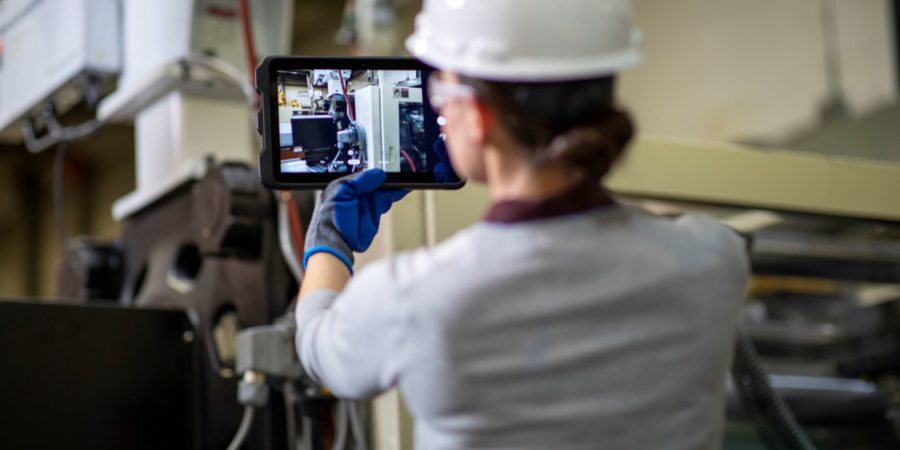As 5G connectivity moves from the networking lab to the real world, it is incredibly exciting to see the innovative ideas that are being explored across a wide range of industries.
With its massive data throughput and ultra-low latency, 5G is truly the pipeline through which emerging technologies like the internet of things (IoT), artificial intelligence (AI), cloud and edge computing and augmented reality (AR) are converging. From AI-powered visual recognition to identify faults in a manufacturing line, to smart agriculture leveraging thousands of sensors and AR-enabled training experiences — the potential is virtually limitless.
However, executing a 5G innovation pilot and scaling it up to full deployment is not easy. It requires a broad set of capabilities and expertise — starting with networking and secure 5G devices, and extending through hybrid cloud, AI development and business transformation strategy. This is the challenge that led IBM and Samsung to come together in 2019 to forge a collaborative platform for 5G and AI-powered enterprise solutions.
At IBM’s Think Digital event on May 6, I joined Nick Otto, IBM’s vice president for strategic partnerships, to discuss our resulting collaboration in the manufacturing and Industry 4.0 space. We were also joined by Mr. Tan Kiat How, Chief Executive for Singapore’s Infocomm Media Development Authority (IMDA), to highlight an important milestone in this partnership — our participation in Singapore’s Smart Nation initiative.
>>Watch the IBM Think Digital session: Put it to the test: What does 5G success look like at enterprise scale?
5G use cases for Industry 4.0
Samsung and IBM, together with Singapore telecom provider M1, are partnering with IMDA to explore Industry 4.0 use cases combining AI, mobile devices and robotics — all accelerated over 5G networks — as part of Singapore’s Digital Economy efforts.
Singapore is embracing the 5G future and has committed to rolling out 5G standalone networks to provide coverage for at least half of Singapore by end-2022, scaling up to nationwide coverage by the end of 2025.
Mr. Tan Kiat How, IMDA Chief Executive, explained:
“Today, amid the uncertainties of COVID-19, Singapore is forging ahead with our 5G plans. Beyond just being connected infrastructure, we believe that these 5G networks are an important innovation infrastructure for a digital economy. A vibrant, dynamic 5G innovation ecosystem drives business transformation and enables exciting new applications. This will unlock new value for industries as well as create new jobs for workers.”
This partnership between IBM, IMDA, M1 and Samsung is focused on piloting Industry 4.0 innovations leveraging 5G, which can then be scaled up within factories in Singapore as well as IBM facilities around the world, Mr. Tan said.
Manufacturing facilities present some of the most exciting opportunities for 5G network adoption due to their size, complexity and the high level of automation already in place. 5G-enabled technology can help manufacturers improve core performance goals like minimizing equipment downtime, improving safety and security, reducing defects and increasing manufacturing flexibility.
IBM and Samsung have been exploring several Industry 4.0 use cases:
- Manufacturers can take advantage of visual recognition and video analytics, as well as acoustic insights, to understand operating performance of equipment in real time and rapidly trouble-shoot issues, supporting improved uptime and reduced defects. Both of these technologies require the transfer and analysis of massive amounts of data and constant real-time AI learning — an area that 5G clearly excels.
- Augmented reality offers great potential for factory field engineers conducting preventative maintenance. Again, AR relies on large data models accessed via a mobile device, as well as streaming of high-resolution video. Without hyperfast 5G, a field engineer could lose hours of productivity in downloading the right AR model, or require multiple technicians to be brought onsite to address an issue which could have been resolved remotely.
Samsung’s collaboration in the IBM Edge ecosystem
When we look more broadly at the challenge of bringing 5G-connected IoT devices to scale, it’s apparent that innovators and creators need a secure and scalable platform on which to build and deploy these kinds of industry use cases. In our view, that platform must be one that is based on open standards to enable interoperability across devices and systems, so customers can “build once, and run anywhere.”
As part of Samsung and IBM’s collaboration around 5G and Edge, Samsung is joining the ecosystem around IBM’s Edge Application Manager, which runs on open source technology from Red Hat.
Evaristus Mainsah, general manager of IBM’s Cloud Pak Ecosystem, described the vision for the IBM Edge Ecosystem to support a whole new level of innovation:
“We want to enable and fuel a broad ecosystem of partners to co-create solutions for a growing set of edge opportunities. With increasing availability of 5G connectivity enabling network slicing, high bandwidth, low latency networks, more and more clients will want to process data, generate insights and take action at the edge; in essence, taking insights to the data to accelerate decisions.
“This is enabled by IBM Edge Application Manager and our broader ecosystem to deliver intelligence at the Edge that is secure and flexible. We are excited about the value that our collaboration with Samsung can bring to our joint clients needing Samsung 5G-enabled edge solutions with Samsung fit for purpose devices.”
Looking ahead at our future collaboration with IBM, it’s very exciting to see how we can combine our respective capabilities and an agile approach to help U.S. customers bring 5G ideas from the lab to enterprise-wide deployment.
A focus on “experience innovation”
Samsung’s core goal has always been enabling customers — whether consumers, industry or government — to achieve a whole new level of productivity, intelligence and connectivity. Much of the initial conversation on 5G has been around broader consumer connectivity and download speed. While the consumer applications are exciting, we see enterprises and governments taking the lead today.
There are signs that private 5G is about to take off. Auto manufacturers are securing 5G spectrum to implement private networks in their factories. Governments are exploring 5G for large facilities, including bases, ports and even on large vessels. Innovative application developers are creating new use cases in entertainment, education and healthcare.
In our view, whether it’s for the consumer or enterprise, the value of 5G connectivity is to enable “experience innovation.” It’s much more than devices and features, but the integration of technology to change the way we live and work. Much is written about Samsung’s end-to-end 5G capabilities from networking equipment to semiconductors and enabled mobile devices. No doubt that is a strength, but equally important is our focus on partnerships with industry peers like IBM and collaboration with our customers to bring these new experiences to life.
Watch the IBM Think Digital Session: “What does 5G success look like at enterprise scale?” Or download this complementary IDC report on developing an enterprise strategy for 5G.







